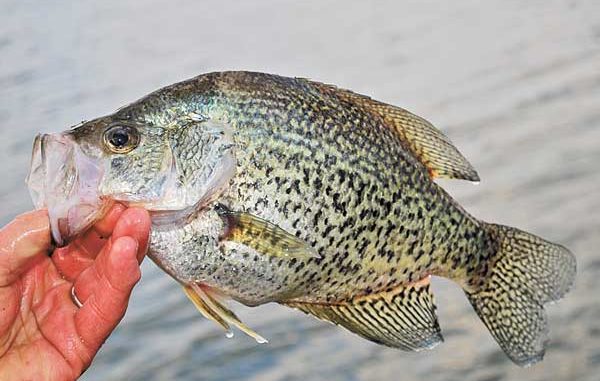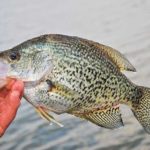
The Louisiana state fish is something special.
In 1993, the Louisiana Legislature picked a state fish. It wasn’t the much-hyped tournament fish, the largemouth bass; it wasn’t any one of the glamorous snapper species; it wasn’t even the beloved speckled trout.
It was the white perch, a.k.a. crappie.
It kinda shows you where our priorities are in Louisiana. Let’s face it: Crappie are pretty anemic fighters, especially compared to their spunky little cousin, the bluegill. They give a protesting wiggle, flop once or twice, and then largely give up to be hauled in.
Oh, but those fillets! The South Louisiana Cajun name for them — sac-a-lait — describes it all — sack of milk. With incredibly white, flaky, mild and sweet flesh, crappie are likely the most popular food fish in Louisiana.
Native throughout the eastern and Midwestern states, crappie carry a lot of local names, including specks, speckled perch, calico bass, strawberry bass, papermouths and Oswego bass. Locally, they are invariably called white perch in north and central Louisiana and sac-a-lait in the southern part of the state.
Local names can be an incredible source of confusion. A perfect example occurs on the website stateanimals.com. There they list the “white perch” as our state fish, which is how it was deemed by the Legislature. The beautiful accompanying illustration is of the “real” white perch, Morone americana, a fish in the striped bass family found exclusively in tidal waters of the mid-Atlantic coast and Chesapeake Bay.
Our fish, or perhaps we should say “fishes” because there are two species lumped together, are the white crappie (Pomoxis annularis) and the black crappie (Pomoxis nigromaculatus).
Biologists use scientific names purposefully to avoid the confusion of local names. The derivation of the name Pomoxis apparently is Greek and refers to the sharp-edged opercula, or gill covers, of the fish. Annularis is Latin for “annual” or “one year old.” Nigromaculatus, also Latin, means “black-spotted,” an accurate description of the color of black crappie.
Both species are found in Louisiana, and while a lot of overlap occurs, some generalizations can be made about the habitat preference of each fish. Large, muddy rivers like the Mississippi and Atchafalaya (yes, there are large populations of crappie in these two rivers.) are almost invariably white crappie. Conversely, the species found in tea-colored or blackwater swamps or freshwater marshes is almost always the black crappie.
Other areas hold a mixture of the two species. But even there some subtle segregation occurs. White crappie tend to be more numerous in areas of flowing water, especially if it is turbid, and black crappie will hold an edge in numbers in connecting still-water areas, especially if aquatic plants are abundant.
In reservoirs the species make-up is all over the place. Some hold predominately or exclusively white crappie, and others, seemingly similar, will be populated by black crappie. And then, some have both in equal numbers.
A peek at the Louisiana Fish Records provides some insight about the distribution of the two species in Louisiana. Seven of the top 10 black crappie were taken from Caney Lake. No two of the top 10 white crappie came from the same place. They were taken from a variety of habitats all over the state including bar pits, reservoirs, natural lakes, bayous, rivers and canals.
Differentiating the two species seems difficult to many anglers at first. Most books recommend counting the dorsal fin spines. If the fish has five or six spines, it is supposed to be a white crappie. If it has seven or eight, it is supposed to be a black crappie.
I find counting spines on fish in the field to be cumbersome. I have also found a few fish that are obviously of one species that have the dorsal spine count of the other. So I suggest using other indicators.
White crappie have a more concave facial profile compared black crappie, and the slope of the head, from the front of the dorsal fin to the tip of the jaw, has a distinct “ski jump” shape to it. Also, a quick glance will show that the length of the base of the dorsal fin in white crappie is significantly shorter than the length of the front of the head from the base of the dorsal fin to the mouth. In black crappie, the two distances are equal.
Finally, with some allowances for the effects of water color and clarity, there are some differences in coloration between the two species. In the white crappie, the black specks are arranged in six or eight rather diffuse but recognizable vertical bars on their silver bodies. In black crappie, the specks are more common, but scattered randomly all over the sides of the fish.
In some populations of black crappie, a minority of individuals will have a wide brown stripe that runs down the length of the front of the face from the front of the dorsal fin down to and including the tip of the lower jaw. Such fish, often called “chocolate crappie,” are the same species as their normal-colored black crappie brethren. While prettier, they fight the same and they taste the same.
Crappie are modest-sized fish. The IGFA world record for black crappie, set in 2006 in a private lake in Missouri, is an even 5 pounds. Louisiana’s state record of 3.55 pounds is jointly held by Jodie E. Crouch Jr., who caught his fish from Toledo Bend Reservoir, and Chet L. Tidwell, whose fish came from Caney Lake. Both were caught in 2003.
The world-record white crappie of 5 pounds, 3 ounces was caught in Enid Dam in Mississippi in 1957. Louisiana’s record is a 3.38-pound fish caught in Grand Bayou Reservoir in April 2002.
Before 1992, the Louisiana Fish Records program kept a generic listing for crappie, combining both species. In those old records, five of the top 10 fish were over 4 pounds in weight, including the much discussed 6.0-pound fish from the Westwego Canal.
The latter fish, which would obviously have been a world record, is much disputed as to its identity, even today. Before 1992, fish submitted for records in Louisiana were not required to have been verified as being the correct species by a biologist.
Jerald Horst is author of four books on fish and seafood, including the acclaimed Trout Masters: How Louisiana’s Best Anglers Catch the Lunkers.




